ART NEWS: January
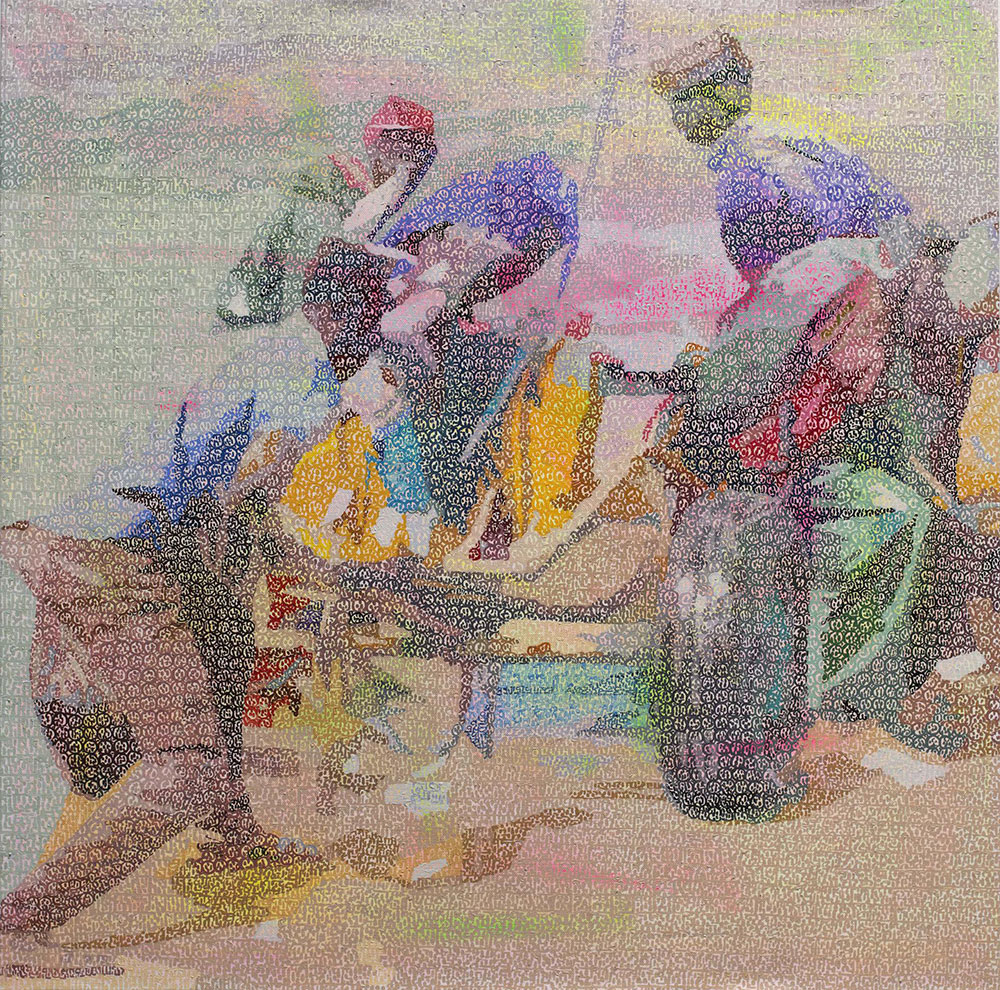 Alioune Diagne is unveiling fifteen large-scale canvases centering on the notions of travel, motion and displacement with the “Tukkii” exhibition. Composed of figurative images created from an infinite number of motifs, Diagne’s work enthralls thanks to its complexity and the energy of the scenes portraying the daily life of the Black community and African diaspora around the world. The exhibition unfurls in a palette of shimmering colors: lime green rubs shoulders with indigo, aquamarine and canary yellow in an explosion of vivid hues. The pieces in this series flirt boldly with abstraction. At first glance, our gaze is lost in the countless marks that make up the painting, none of them identical. It is only by standing back from the canvas that we can make out the local scenes, captured in all their artlessness. One of them depicts a market scene while another shows a morning gathering in the street. Under their inconsequential appearance lies an opportunity for the artist to question the ambivalence of the “tukki”, the journey in Africa, evoking his father’s experience: when looking for work, he and his companions were forced to take long journeys to far-off places. Diagne’s work, nourished by his own travels, aims to highlight the dignity of this diaspora and the African community he grew up in. Info: Galerie Templon, Veydtstraat 13A, Brussels, Belgium, Duration: 14/1-4/3/2023, Days & Hours: Tue-Sat 11:00-18:00, www.templon.com/
Alioune Diagne is unveiling fifteen large-scale canvases centering on the notions of travel, motion and displacement with the “Tukkii” exhibition. Composed of figurative images created from an infinite number of motifs, Diagne’s work enthralls thanks to its complexity and the energy of the scenes portraying the daily life of the Black community and African diaspora around the world. The exhibition unfurls in a palette of shimmering colors: lime green rubs shoulders with indigo, aquamarine and canary yellow in an explosion of vivid hues. The pieces in this series flirt boldly with abstraction. At first glance, our gaze is lost in the countless marks that make up the painting, none of them identical. It is only by standing back from the canvas that we can make out the local scenes, captured in all their artlessness. One of them depicts a market scene while another shows a morning gathering in the street. Under their inconsequential appearance lies an opportunity for the artist to question the ambivalence of the “tukki”, the journey in Africa, evoking his father’s experience: when looking for work, he and his companions were forced to take long journeys to far-off places. Diagne’s work, nourished by his own travels, aims to highlight the dignity of this diaspora and the African community he grew up in. Info: Galerie Templon, Veydtstraat 13A, Brussels, Belgium, Duration: 14/1-4/3/2023, Days & Hours: Tue-Sat 11:00-18:00, www.templon.com/
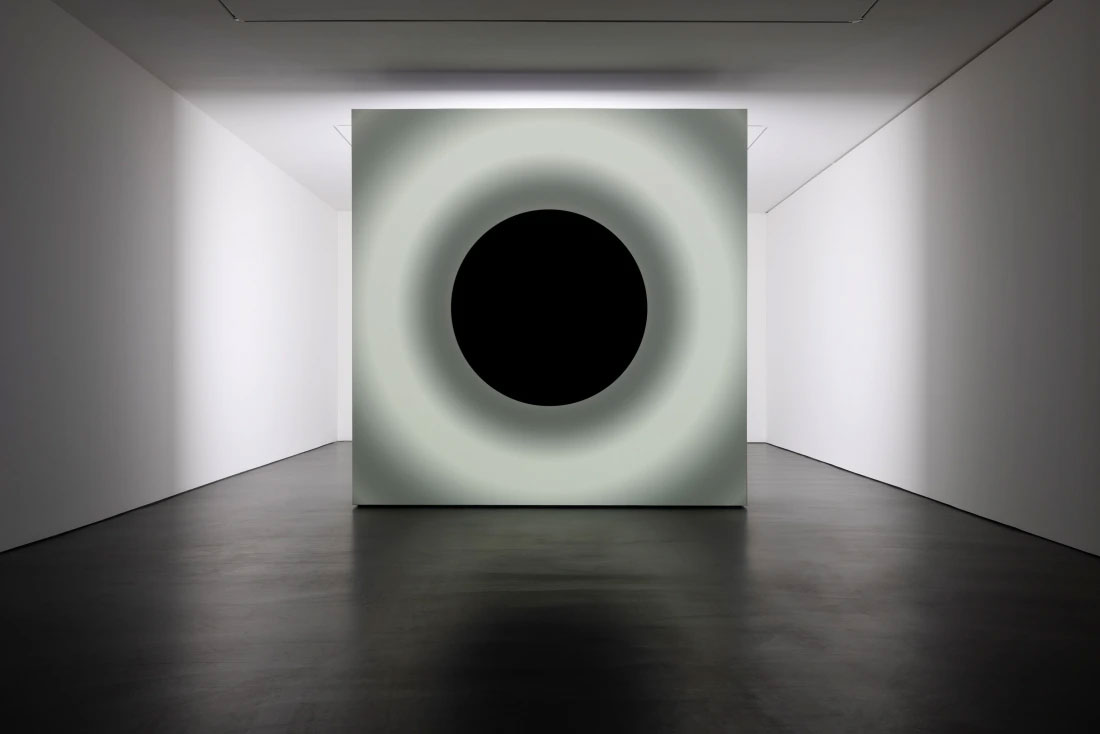 Japan’s leading electronic composer and visual artist Ryoji Ikeda focuses on the essential characteristics of sound itself and that of visuals as light by means of both mathematical precision and mathematical aesthetics. Ikeda has gained a reputation as one of the few international artists working convincingly across both visual and sonic media. He elaborately orchestrates sound, visuals, materials, physical phenomena and mathematical notions into immersive live performances and installations. Ryoji Ikeda’s work “point of no return” (2018) consists of a wall module with two light projections. One side of the wall shows a constant white circle, cast by a powerful theater light. The other side of the wall functions as a screen for a video projection, showing an abstract visual of a pulsating black circle. The video is continuously generated by a software and its pattern never repeats itself. The spatial conflation of two luminous opposites creates a destabilizing and immersive physical effect. The work’s title borrows from an astrophysics’ term that defines the point at the event horizon of a black hole, where materials can no longer escape the hole’s gravitation force. Info: Esther Schipper Gallery, Potsdamer Straße 81E, Berlin, Germany, Duration: 20/1-25/2/2023, Days & Hours: Tue-Sat 11:00-18:00, www.estherschipper.com/
Japan’s leading electronic composer and visual artist Ryoji Ikeda focuses on the essential characteristics of sound itself and that of visuals as light by means of both mathematical precision and mathematical aesthetics. Ikeda has gained a reputation as one of the few international artists working convincingly across both visual and sonic media. He elaborately orchestrates sound, visuals, materials, physical phenomena and mathematical notions into immersive live performances and installations. Ryoji Ikeda’s work “point of no return” (2018) consists of a wall module with two light projections. One side of the wall shows a constant white circle, cast by a powerful theater light. The other side of the wall functions as a screen for a video projection, showing an abstract visual of a pulsating black circle. The video is continuously generated by a software and its pattern never repeats itself. The spatial conflation of two luminous opposites creates a destabilizing and immersive physical effect. The work’s title borrows from an astrophysics’ term that defines the point at the event horizon of a black hole, where materials can no longer escape the hole’s gravitation force. Info: Esther Schipper Gallery, Potsdamer Straße 81E, Berlin, Germany, Duration: 20/1-25/2/2023, Days & Hours: Tue-Sat 11:00-18:00, www.estherschipper.com/
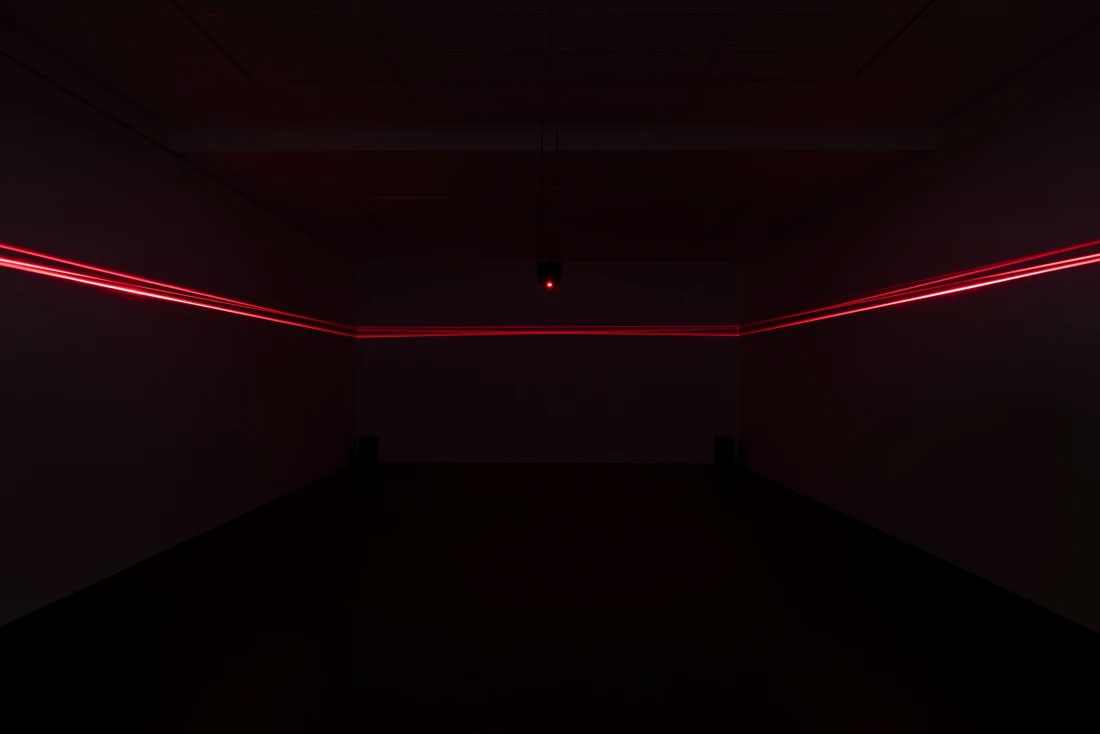 A central motif in the practice of the Finnish artist duo Tommi Grönlund and Petteri Nisunen, who began working together as Grönlund-Nisunen in 1993, is transforming their curiosity about elemental forces such as gravity, magnetism, or radiation into quietly evocative works that convey fundamental principles of these conditions. Grönlund-Nisunen’s works often employ the behaviors of natural elements to communicate specific or generalized physical phenomena. The new work, “Scattered Horizon”, presents three swaying lines, which hit the walls of the otherwise dark exhibition space. The horizon is generally taken for granted as a singular, fixed occurrence in nature, so the sight of it elevated, tripled and in constant movement can have a slightly disorienting effect. A complementary sound element of three sine wave tones modulating with each other adds another physical sensation, as the low frequency vibrations can be felt in one’s body. In this context, the term “immersive” describes the encounter in a literal sense: engaging visitors in a multi-sensory experience, the work is visible, audible, and palpable. We depend on the stability of our surroundings both physically and psychologically; that is why losing the stabilizing horizon line, and adapting to it, can be experienced either as meditative, thrilling or even uncomfortable, depending on the visitor. Scattered Horizon plays on these associations, but also leaves visitors the freedom to explore their physical presence and emotional response. Info: Esther Schipper Gallery, Potsdamer Straße 81E, Berlin, Germany, Duration: 20/1-25/2/2023, Days & Hours: Tue-Sat 11:00-18:00, www.estherschipper.com/
A central motif in the practice of the Finnish artist duo Tommi Grönlund and Petteri Nisunen, who began working together as Grönlund-Nisunen in 1993, is transforming their curiosity about elemental forces such as gravity, magnetism, or radiation into quietly evocative works that convey fundamental principles of these conditions. Grönlund-Nisunen’s works often employ the behaviors of natural elements to communicate specific or generalized physical phenomena. The new work, “Scattered Horizon”, presents three swaying lines, which hit the walls of the otherwise dark exhibition space. The horizon is generally taken for granted as a singular, fixed occurrence in nature, so the sight of it elevated, tripled and in constant movement can have a slightly disorienting effect. A complementary sound element of three sine wave tones modulating with each other adds another physical sensation, as the low frequency vibrations can be felt in one’s body. In this context, the term “immersive” describes the encounter in a literal sense: engaging visitors in a multi-sensory experience, the work is visible, audible, and palpable. We depend on the stability of our surroundings both physically and psychologically; that is why losing the stabilizing horizon line, and adapting to it, can be experienced either as meditative, thrilling or even uncomfortable, depending on the visitor. Scattered Horizon plays on these associations, but also leaves visitors the freedom to explore their physical presence and emotional response. Info: Esther Schipper Gallery, Potsdamer Straße 81E, Berlin, Germany, Duration: 20/1-25/2/2023, Days & Hours: Tue-Sat 11:00-18:00, www.estherschipper.com/
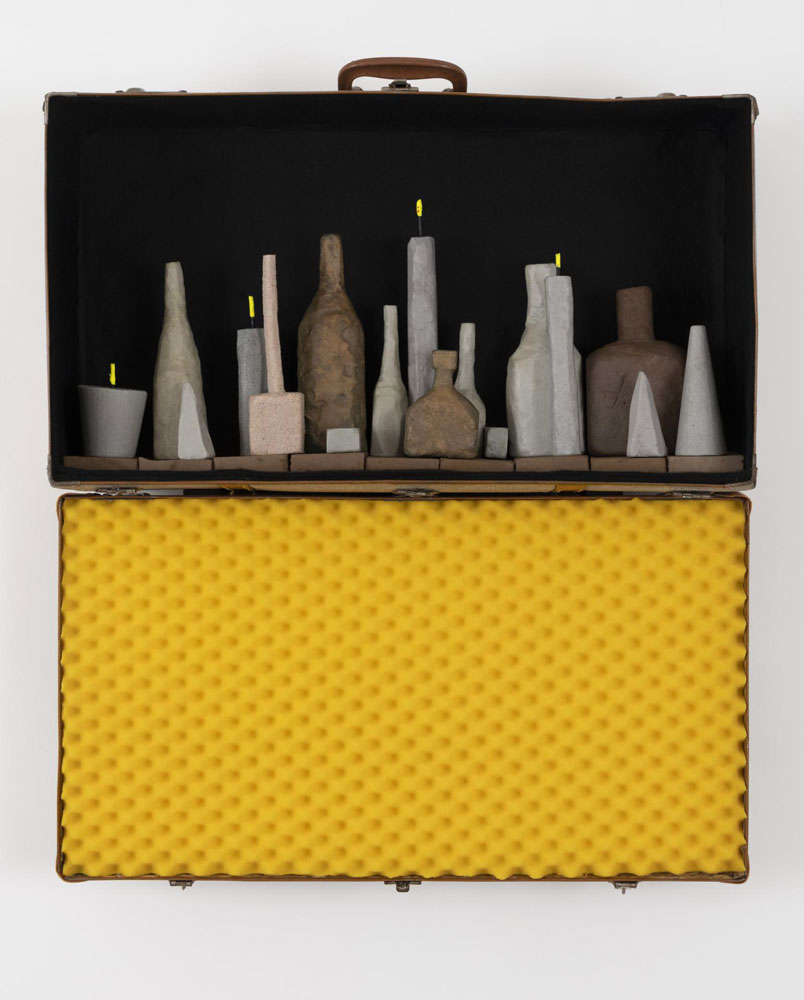 Rodrigo Matheus’ solo exhibition “L’Antichambre” unveils a group of new works by the artist, subtle compositions made of ordinary objects. The recent mural sculptures inscribe themselves in the continuity of his examination of assemblages of eclectic things. Between his capacity to disjoint them and his desire to fit them back together, the diverse elements become entangled, enter into dialog with each other. These assemblages yield surprising compositions that border on abstraction, lending the objects a new dimension that goes beyond their normal usage. For his new series, Rodrigo Matheus chose to exhibit elements that are as ordinary as they are clashing: plain windows whose openings are blocked by a metallic grate share the space with suitcases spilling their contents, presented vertically along the wall. Most of the elements outside and inside the exhibited objects – like the uneven bricks around the windows or the minutely aligned containers in the suitcase – were made entirely by the artist from blocks of polyurethane foam. This lightweight material is easy to sculpt and gives the works a sense of weight and density. The unusual assembly of each element, coupled with the trompe-l’oeil quality of their material composition, puts the viewer in an unstable and mysterious space, at the gates of reality. Info: Galerie Nathalie Obadia, 3, rue du Cloître Saint-Merri, Paris, France, Duration: 21/1-8/3/2023, Days & Hours: Mon-Sat 11:00-19:00, www.nathalieobadia.com/
Rodrigo Matheus’ solo exhibition “L’Antichambre” unveils a group of new works by the artist, subtle compositions made of ordinary objects. The recent mural sculptures inscribe themselves in the continuity of his examination of assemblages of eclectic things. Between his capacity to disjoint them and his desire to fit them back together, the diverse elements become entangled, enter into dialog with each other. These assemblages yield surprising compositions that border on abstraction, lending the objects a new dimension that goes beyond their normal usage. For his new series, Rodrigo Matheus chose to exhibit elements that are as ordinary as they are clashing: plain windows whose openings are blocked by a metallic grate share the space with suitcases spilling their contents, presented vertically along the wall. Most of the elements outside and inside the exhibited objects – like the uneven bricks around the windows or the minutely aligned containers in the suitcase – were made entirely by the artist from blocks of polyurethane foam. This lightweight material is easy to sculpt and gives the works a sense of weight and density. The unusual assembly of each element, coupled with the trompe-l’oeil quality of their material composition, puts the viewer in an unstable and mysterious space, at the gates of reality. Info: Galerie Nathalie Obadia, 3, rue du Cloître Saint-Merri, Paris, France, Duration: 21/1-8/3/2023, Days & Hours: Mon-Sat 11:00-19:00, www.nathalieobadia.com/
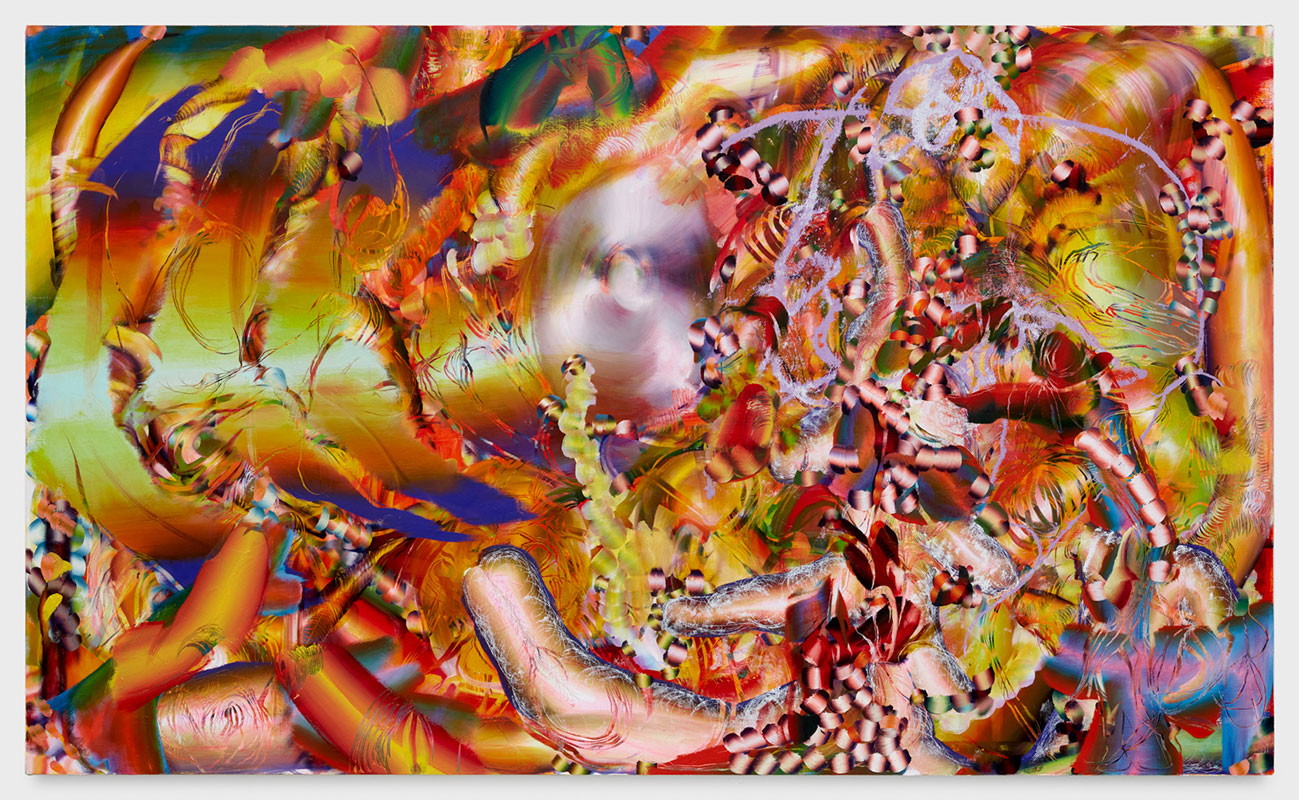 Lauren Quin showcases new paintings in her solo exhibition “My Hellmouth”. Her abstract paintings exist at the juncture of the deeply personal and the universal, the point where each begins to bleed into the other—for, as she proves in her work, if you go too far into either, you are certain to loop back into its opposite. The artist is dealing in modes of communication both micro and macro, internal and external, to achieve her keenly allusive repertoire of imagery and forms of mark making. Quin’s compositions flood the viewer with an intense combination of color and symbolism. The artist deploys a host of moments and symbols as structural devices within each work, making archetypes out of figures that she collects and expands upon through a sketching practice. The artist’s paintings are initially built from a shape that is repeated and overlapped. This layering process creates a multitude of compositional center points as well as other forms that appear in the residual spaces. Each painting is also topped with motifs derived from Quin’s drawing archive—a spider, a hand, the sun, a needle—that she transfers onto the canvas with a meticulously honed monoprinting technique. As the artist uses her symbols again and again, they grow from a personally sourced visual language into a collective, cultural unconscious—the meaning expands and erodes, taking on a life of its own as each viewer forms their own attachment to these works. Info: Nerman Museum of Contemporary Art, Johnson County Community College, 12345 College Blvd, Overland Park, KS, USA, Duration: 21/1-18/6/2023, Days & Hours: Tue, Fri-Sat 10;00-17:00, Wed-Thu 10:00-20:00, Sun 12:00-17:00, www.nermanmuseum.org/
Lauren Quin showcases new paintings in her solo exhibition “My Hellmouth”. Her abstract paintings exist at the juncture of the deeply personal and the universal, the point where each begins to bleed into the other—for, as she proves in her work, if you go too far into either, you are certain to loop back into its opposite. The artist is dealing in modes of communication both micro and macro, internal and external, to achieve her keenly allusive repertoire of imagery and forms of mark making. Quin’s compositions flood the viewer with an intense combination of color and symbolism. The artist deploys a host of moments and symbols as structural devices within each work, making archetypes out of figures that she collects and expands upon through a sketching practice. The artist’s paintings are initially built from a shape that is repeated and overlapped. This layering process creates a multitude of compositional center points as well as other forms that appear in the residual spaces. Each painting is also topped with motifs derived from Quin’s drawing archive—a spider, a hand, the sun, a needle—that she transfers onto the canvas with a meticulously honed monoprinting technique. As the artist uses her symbols again and again, they grow from a personally sourced visual language into a collective, cultural unconscious—the meaning expands and erodes, taking on a life of its own as each viewer forms their own attachment to these works. Info: Nerman Museum of Contemporary Art, Johnson County Community College, 12345 College Blvd, Overland Park, KS, USA, Duration: 21/1-18/6/2023, Days & Hours: Tue, Fri-Sat 10;00-17:00, Wed-Thu 10:00-20:00, Sun 12:00-17:00, www.nermanmuseum.org/
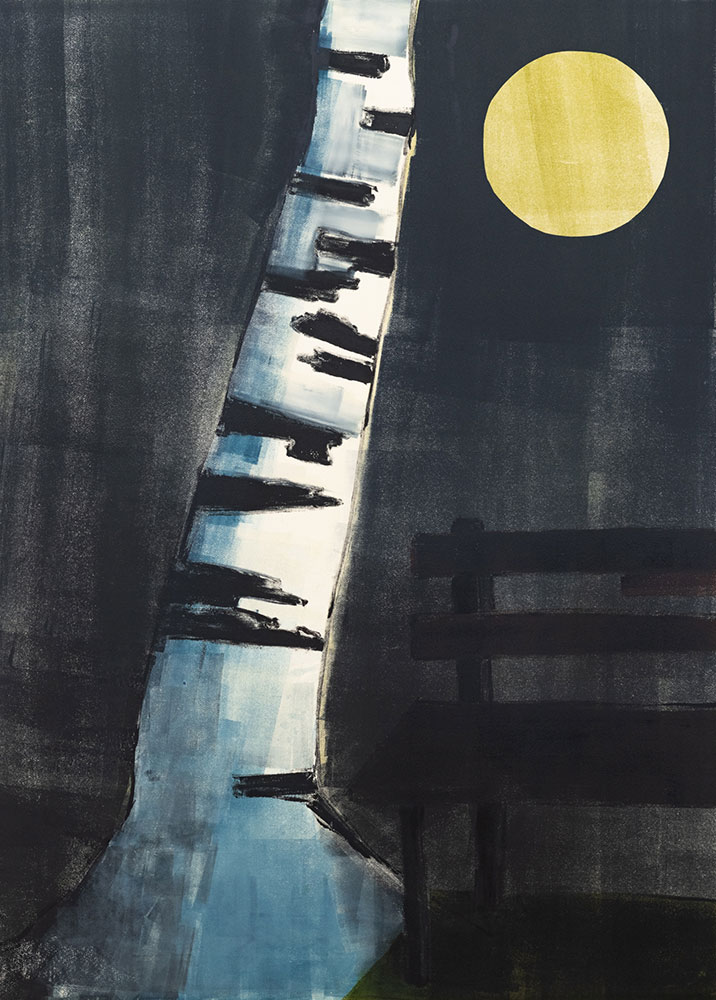 In the past years, Zilla Leutenegger has created an extensive oeuvre that is focused on a cross-media exploration of two-dimensionality, space, and the figure in space. The new works connect many characteristic elements of Zilla’s artistic practice, such as the moving drawing and the interplay of surface, light and shadow, creating spectrum of familiar, as well as new content. On view are two new series of monotypes in various formats, a new room-filling video installation, as well as a group of small ceramic works. The works of the exhibition “I Love You to the Moon and Back” describe a journey of emotion and, in Zilla Leutenegger’s case, is also an ode to the beauty of the everyday that we all too often overlook in the hustle and bustle of everyday life. In her work, a few means are often enough to win us over to the poetry of the moment, to make us pause and marvel. Strokes and shapes wander out of the surface and miraculously merge with the third dimension making us part of their imaginary world. Info: Galerie Peter Kilchmann, Zahnradstrasse 21, Zurich, Duration: 21/8-18/3/2023, Days & Hours: Tue-Fri 10:00-18:00, Sat 11:00-17:00, www.peterkilchmann.com/
In the past years, Zilla Leutenegger has created an extensive oeuvre that is focused on a cross-media exploration of two-dimensionality, space, and the figure in space. The new works connect many characteristic elements of Zilla’s artistic practice, such as the moving drawing and the interplay of surface, light and shadow, creating spectrum of familiar, as well as new content. On view are two new series of monotypes in various formats, a new room-filling video installation, as well as a group of small ceramic works. The works of the exhibition “I Love You to the Moon and Back” describe a journey of emotion and, in Zilla Leutenegger’s case, is also an ode to the beauty of the everyday that we all too often overlook in the hustle and bustle of everyday life. In her work, a few means are often enough to win us over to the poetry of the moment, to make us pause and marvel. Strokes and shapes wander out of the surface and miraculously merge with the third dimension making us part of their imaginary world. Info: Galerie Peter Kilchmann, Zahnradstrasse 21, Zurich, Duration: 21/8-18/3/2023, Days & Hours: Tue-Fri 10:00-18:00, Sat 11:00-17:00, www.peterkilchmann.com/
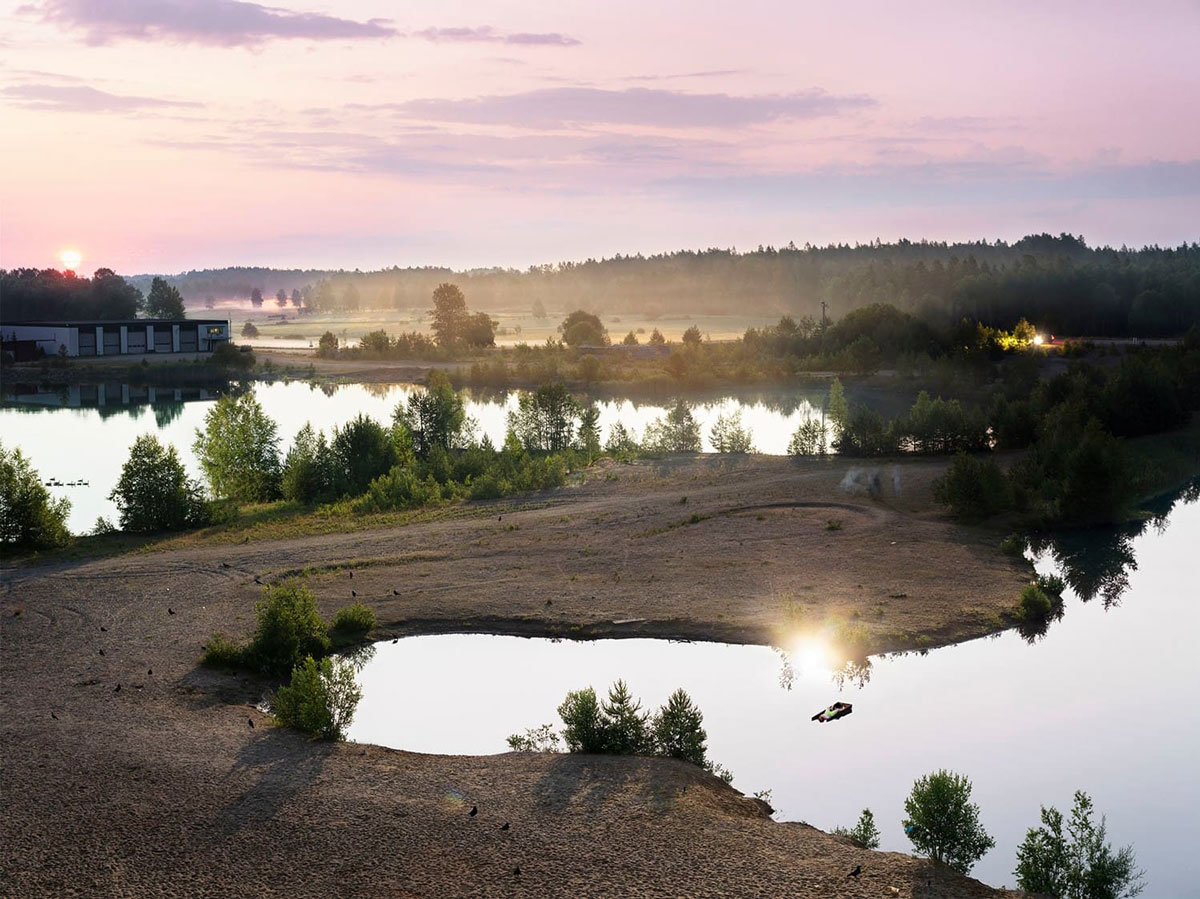 Ulf Lundin in his solo exhibition “Best of Sweden” presents a photographic project that he has worked on for the past four years. In the project, Ulf Lundin has photographed the same scene from early morning before dawn until it gets dark again in the evening. The final image is composed of different parts from a selection of exposures he took during the day. It can be night in one corner of the picture, noon in another and a small detail can be illuminated by the early morning light. A whole day compressed into one image. The title of the project alludes to the subjective choices Lundin makes when deciding which parts of the photographs to use in the final composition, but also to the places he chooses to photograph. Photography is in many cases used to confirm our view of the world around us. Lundin has chosen common and unremarkable places, which we may not usually associate with the image of Sweden. They are not made for the eye, but here they are presented in an idealized light. The project raises the question about what a photograph is and how we perceive it, but also about the environment surrounding us and how we influence, and are influenced by it. Info: Galleri Magnus Karlsson, Fredsgatan 12, Stockholm, Sweden, Duration: 28/1-5/2/2023, Days & Hours: Tue-Fri 12:00-17:00, Sat 12:00-16:00, www.gallerimagnuskarlsson.com/
Ulf Lundin in his solo exhibition “Best of Sweden” presents a photographic project that he has worked on for the past four years. In the project, Ulf Lundin has photographed the same scene from early morning before dawn until it gets dark again in the evening. The final image is composed of different parts from a selection of exposures he took during the day. It can be night in one corner of the picture, noon in another and a small detail can be illuminated by the early morning light. A whole day compressed into one image. The title of the project alludes to the subjective choices Lundin makes when deciding which parts of the photographs to use in the final composition, but also to the places he chooses to photograph. Photography is in many cases used to confirm our view of the world around us. Lundin has chosen common and unremarkable places, which we may not usually associate with the image of Sweden. They are not made for the eye, but here they are presented in an idealized light. The project raises the question about what a photograph is and how we perceive it, but also about the environment surrounding us and how we influence, and are influenced by it. Info: Galleri Magnus Karlsson, Fredsgatan 12, Stockholm, Sweden, Duration: 28/1-5/2/2023, Days & Hours: Tue-Fri 12:00-17:00, Sat 12:00-16:00, www.gallerimagnuskarlsson.com/
